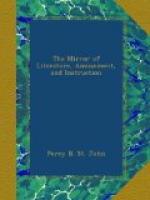The scene took place at Rangoon, and the sufferers were men of desperate characters, who merited death. At a short distance from the town, on the road known to the army by the name of the Forty-first Lines, is a small open space, which formerly was railed in: and here all criminals used to be executed. On this occasion several gibbets, about the height of a man, were erected, and a large crowd of Burmans assembled to feast their eyes on the sanguinary scene that was to follow.
When the criminals arrived, they were tied within wooden frames, with extended arms and legs, and the head-executioner going round to each, marked with a piece of chalk, on the side of the men, in what direction his assistant (who stood behind him with a sharpened knife,) was to make the incision. On one man he described a circle on the side; another had a straight line marked down the centre of his stomach; a third was doomed to some other mode of death; and some were favoured by being decapitated. These preparations being completed, the assistant approached the man marked with a circle, and seizing a knife, plunged it up to the hilt in his side, then slowly and deliberately turning it round, he finished the circle! The poor wretch rolled his eyes in inexpressible agony, groaned, and soon after expired; thus depriving these human fiends of the satisfaction his prolonged torments would have afforded them. The rest suffered in the same manner; and, from the specimens I have seen of mangled corpses, I do not think this account overdrawn. Hanging is a punishment that seldom, if ever, takes place.
The manner in which slighter punishments are made is peculiar to the Burmans, and, as nearly as I can make it out, according to our pronunciation, is called “toung.” The delinquent is obliged to kneel down, and a man stands over him with a bent elbow and clenched fist. He first rapidly strikes him on the head with his elbow, and then slides it down until his knuckles repeat the blow, the elbow at the same time giving a violent smack on the shoulders. This is repeated until it becomes a very severe punishment, which may be carried to great excess.—Two Years in Ava.
* * * * *
RETROSPECTIVE GLEANINGS.
* * * * *
BILL OF FARE AT AN ANCIENT INSTALMENT.
The following is a true copy of the original lodged in the Tower of London:[2]—
George Nevil, brother to the great Earl of Warwick, at his instalment into his archbishopric of York, in the year 1470, made a feast for the nobility, gentry, and clergy, wherein he spent:
300 quartrs of wheat
300 ton of ale
104 ton of wine
1 pipe of
spic’d w.
80 fat oxen
6 wild bulls
300 pigs
1004 wethers
300 hogs
300 calves
3000 geese




